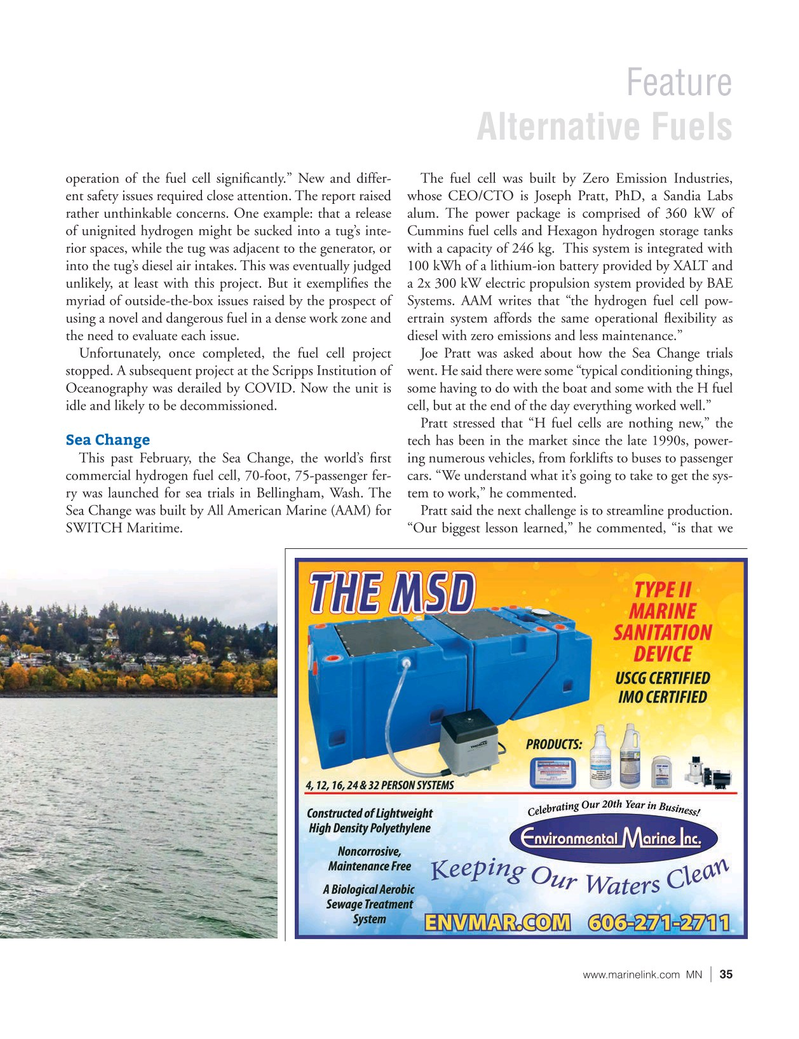
Page 35: of Marine News Magazine (July 2022)
Propulsion Technology
Read this page in Pdf, Flash or Html5 edition of July 2022 Marine News Magazine
Feature
Alternative Fuels need to make this a lot simpler and go from 300 different way right now to revise Subchapter T to include H or steps down to ? ve.” Pratt wants to deliver a fuel cell package lithium-ion battery propulsion.
like a diesel engine gets delivered. Then, the shipyard can Strom explained that the Sea Change crew, as with all work with a unit, rather than a process. “We want the ship- vessels, must demonstrate the ability to respond to “? re, yard to be able to drop them into the boat and connect a ? ooding, abandon ship, and man overboard situations.” few hoses,” Pratt explained. “That’s what we’re working on With the Sea Change, veri? cation also included an “assess- right now, to make it easy for vessel owners and shipyards.” ment of the crew’s hydrogen-speci? c knowledge and a fur-
The Coast Guard participated in the Bellingham sea tri- ther assessment of their ability to prevent and respond to all als. CDR Frank Strom, Chief, Systems Engineering Divi- emergencies onboard the vessel, including those associated sion, Of? ce of Design and Engineering Standards at Coast with the hydrogen fuel system and lithium-ion batteries.”
Guard Headquarters, explained that the CG’s inspections This process continues when the Sea Change moves to were to “verify compliance with 46 CFR Subchapter T re- San Francisco, its future port. Then, inspections will focus quirements,” focusing on mechanical and electrical systems on hydrogen bunkering, crew training and competency, including propulsion, steering, navigation, and automa- and operational requirements presented by the use of hy- tion. These inspections mostly occur at the pier but an “un- drogen as fuel. The goal is for Sea Change to earn its Cer- derway trial,” is also required and, indeed, was completed. ti? cate of Inspection so that it can carry passengers.
Strom was asked about hydrogen speci? c issues. He said that current Subchapter T regs do not consider the DNV forecast use of lithium-ion batteries or hydrogen as fuel. The Sea In June, DNV released an extensive document – Hydro-
Change is regulated by “a design basis agreement,” he gen Forecast to 2050 - DNV – a close look at hydrogen’s explained, “which serves to augment federal regulations potential to become a central fuel by 2050. The Forecast with applicable hydrogen safety and construction stan- focuses on Europe, but the advisories are applicable in the dards in order to achieve an equivalent level of safety.” U.S., and elsewhere, of course.
During Sea Change construction, the Coast Guard “veri- DNV estimates that H will provide 5% of global energy ? ed that the hydrogen and lithium-ion battery systems demand by 2050, although likely to meet 11% in Europe. were performing in accordance with their design, which The 5% level is too low for H to proportionately contrib- was made to those standards.” There is no effort under- ute to Paris Agreement reductions.
The Hydrogen
One towboat, being developed by Maritime
Partners, Elliott
Bay Design Group, e1 Marine and
ABB, will use e1
Marine’s reformer technology to generate hydrogen from methanol on-demand.
Elliott Bay Design Group 36 | MN July 2022

 34
34

 36
36
